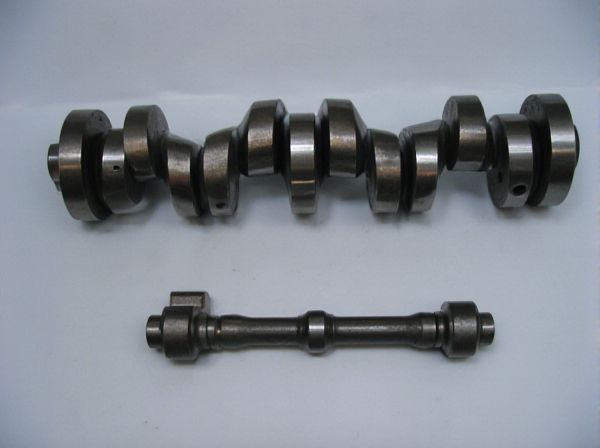
Photo illustration: Billet crankshaft vs Nodular iron crankshaft
Billet crankshafts offer superior strength and durability due to their manufacturing from a solid piece of high-quality steel, making them ideal for high-performance engines. Nodular iron crankshafts provide good fatigue resistance and cost-effectiveness thanks to their nodular graphite microstructure enhancing toughness. Your choice depends on the balance between performance requirements and budget constraints, with billet crankshafts excelling in demanding applications.
Table of Comparison
| Feature | Billet Crankshaft | Nodular Iron Crankshaft |
|---|---|---|
| Material | High-grade steel billet | Nodular iron (ductile cast iron) |
| Manufacturing | Machined from solid steel block | Cast and heat-treated |
| Strength | Superior tensile and fatigue strength | Moderate strength, less fatigue resistance |
| Durability | High durability, ideal for high-performance engines | Good durability for standard applications |
| Weight | Lighter due to precise machining | Heavier due to casting process |
| Cost | Higher cost - premium performance parts | Lower cost - budget-friendly |
| Application | Racing, high-performance, custom builds | Standard vehicles, moderate performance |
Introduction to Crankshaft Materials
Billet crankshafts are machined from a single piece of high-quality steel, offering superior strength, durability, and precision compared to cast materials. Nodular iron crankshafts, made from ductile cast iron, provide excellent wear resistance and cost-effectiveness but have lower tensile strength and fatigue resistance than billet steel. Material selection between billet and nodular iron crankshafts depends on engine performance requirements, manufacturing complexity, and budget constraints.
What is a Billet Crankshaft?
A billet crankshaft is a high-performance engine component meticulously machined from a solid block of premium steel, offering superior strength and precision compared to cast or nodular iron crankshafts. Its manufacturing process allows for enhanced durability, reduced weight, and improved resistance to fatigue, making it ideal for racing and high-stress applications. Billet crankshafts provide better engine balance and performance optimization, outperforming nodular iron crankshafts which are typically cast and less resilient under extreme conditions.
What is a Nodular Iron Crankshaft?
A nodular iron crankshaft is made from ductile iron, characterized by its spherical graphite nodules which enhance strength and flexibility compared to traditional cast iron. This material provides improved fatigue resistance and vibration damping, making nodular iron crankshafts durable for heavy-duty engines. Billet crankshafts, however, are machined from forged steel, offering superior strength and precision but at a higher manufacturing cost compared to nodular iron crankshafts.
Manufacturing Process Comparison
Billet crankshafts are precision-machined from a solid piece of high-grade steel, involving CNC milling and turning to achieve exact dimensions and superior strength. Nodular iron crankshafts are produced using a casting process where molten nodular cast iron is poured into molds, allowing for complex shapes but with less tensile strength compared to billet steel. The billet process offers enhanced fatigue resistance and dynamic balance due to precise machining, whereas nodular iron casting prioritizes cost-effectiveness and efficient mass production.
Strength and Durability Differences
Billet crankshafts, machined from a single piece of high-grade alloy steel, offer superior strength and durability due to their uniform grain structure and resistance to fatigue, making them ideal for high-performance applications. Nodular iron crankshafts, cast from ductile iron with spherical graphite nodules, provide good toughness and wear resistance but generally have lower tensile strength and fatigue life compared to billet steel. The enhanced mechanical properties of billet crankshafts translate into better performance under extreme stress and longer service intervals in demanding engines.
Performance Applications
Billet crankshafts, machined from a solid piece of high-grade steel alloy, exhibit superior strength and fatigue resistance, making them ideal for high-performance and racing applications where extreme stress and RPMs are common. Nodular iron crankshafts, cast from ductile iron with added nodular graphite, provide good durability and cost-effectiveness but tend to have lower tensile strength and fatigue life compared to billet counterparts. Consequently, billet crankshafts are preferred in performance engines seeking maximum power output and reliability under rigorous operating conditions.
Cost Comparison
Billet crankshafts are manufactured from a solid piece of high-grade steel, offering superior strength and precision but at a significantly higher cost compared to nodular iron crankshafts. Nodular iron crankshafts, made from ductile cast iron, provide a cost-effective solution with good durability for standard applications, making them ideal for budget-conscious projects. The initial investment for billet crankshafts can be up to three times greater than nodular iron counterparts, reflecting their enhanced material properties and manufacturing complexity.
Weight and Balance Considerations
Billet crankshafts are machined from high-grade steel billets, offering superior weight reduction and enhanced balance due to their precise manufacturing process, which minimizes imbalances and vibrations. Nodular iron crankshafts, made from cast iron with added graphite nodules, are heavier and less uniform, often requiring additional balancing to reduce engine stress and wear. Weight savings and improved balance in billet crankshafts contribute to higher RPM capabilities and increased engine durability compared to the typically heavier and less dynamically balanced nodular iron options.
Pros and Cons of Billet Crankshafts
Billet crankshafts offer superior strength and durability due to their manufacturing from a single piece of high-grade steel, providing enhanced resistance to fatigue and stress compared to nodular iron crankshafts. Their precision machining ensures optimal balance and performance, making them ideal for high-performance and racing applications, but this comes with a higher cost and longer production time. However, billet crankshafts are less brittle than nodular iron alternatives, reducing the risk of catastrophic failure under extreme loads while requiring specialized equipment for fabrication and repair.
Pros and Cons of Nodular Iron Crankshafts
Nodular iron crankshafts offer enhanced strength and wear resistance due to their unique graphite nodules, making them more resilient to fatigue and impact than cast iron alternatives. They are more cost-effective to produce compared to billet crankshafts, providing a balance between performance and affordability for mass production engines. However, nodular iron crankshafts typically have lower tensile strength and less precision machining capability than billet crankshafts, which may limit their use in high-performance or racing applications.
 caratoz.com
caratoz.com